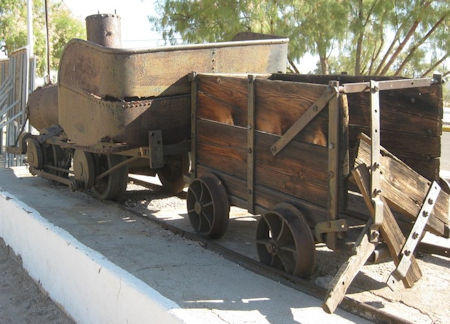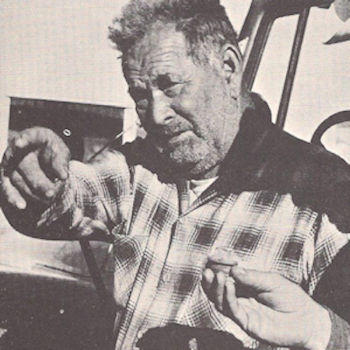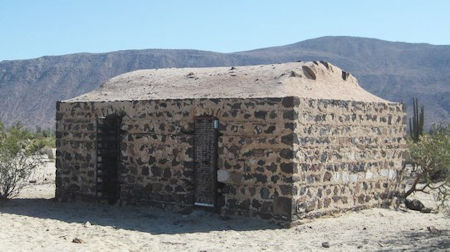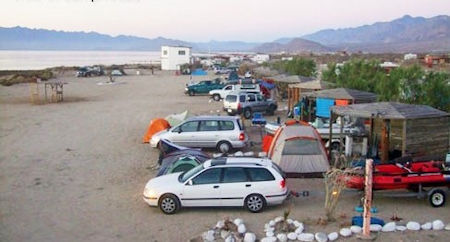 |  |
By Greg Niemann

Today’s travelers to Bahía de los Ángeles, that idyllic little village on the sparkling Sea of Cortez are usually interested in fishing and relaxing. Early settlers to the area, however, had a different goal – they were drawn to the nearby hills and mountains in pursuit of valuable ore.
Mining for gold, silver, and copper began about 1880 in the Bahía de los Ángeles area, with the first mine called the Santa Marta. Then capitalists from Sonora, Mexico developed the San Juan silver mine which became the largest producing mine in all of Baja California.
The San Juan mine was eight miles back into the mountains, so a narrow-gauge railroad using a scaled-down engine and cars was built to transport the ore from the mine to a mill where a small town called Las Flores came into being. At the base of the mountains, Las Flores rests on the flat desert floor about nine miles south of the spring-fed village of Bahía de los Ángeles.
Heavy mining and milling machinery was brought into the bay by boat. Mule, burro and wagon trains then transported it all to Las Flores, with much of the machinery having to be dismantled and reassembled.
The mine flourished for a time, and legend has it that $2 million worth of silver was recovered. They even strung up a telephone from the loading dock to the Las Flores processing area and on up to the San Juan mine.
The mine has not been worked since the Mexican Revolution of 1910, so the mill town of Las Flores lost its reason for existence. After the town died, most of the buildings were torn down for lumber. Today visitors who drive down the dirt road from Bahía de los Ángeles can still find evidence of the town, a few rusting hulks of machinery, pilings, and most notably, an historic old stone jail. Since my first visit, much of the relics, including parts of the old train, have been removed for preservation at the natural history museum in town.

They Wrote the Area’s History
I had been to Las Flores several times before I noticed a small cemetery adjacent to the town’s remains. There, inscribed on modest headstones, were the names of those who wrote the area’s history. The most prominent marker simply said, “Richard Daggett, 1893-1969, En Paz Descanse (Rest in Peace). That would have been Dick Daggett Jr., I mused, knowing that his father had arrived in the early 1880s.
Other markers tied the early Anglo family with another family of early settlers, and connected the past with the present: “Reyes de Daggett, 12-12-1897, at age of 23 Years,” “Isabel Arce,” “Germana Arce, 1901, 30 Years Old,” “Josefa Arce de Daggett, 19 March 1888--3 December 1972,” and “Rene Daggett, 30 August 1962-2 October 1994.” Also buried at Las Flores is the family patriarch himself, Dick Daggett Sr.
Daggett Jumped Ship
Daggett Sr., an Englishman from Oxford, England, was a junior officer on a German ship that came to the port with bricks for the new mine buildings. He disliked his captain and jumped ship. The German captain came ashore and searched for the deserter, but Daggett’s new Mexican friends hid him in a cave. The captain unknowingly hired the same man who hid Daggett to search for him, and that man led the German on a wild goose chase. Frustrated, the captain sailed off without his English junior officer.
Daggett got a job at the Las Flores mine and married a young girl from the Arce family of San Ignacio. He became the mine superintendent in 1892. For a while he was partners with Señor Arturo Grosso, an Italian miner, two of whose children, Anita Espinoza (El Rosario) and Arturo Grosso (Chapala), went on to become familiar Baja legends.
One source reported that in addition to the San Juan mine, in the early 1900s Daggett also worked the area’s King Richard (La Josefina) gold mine.

Dick Daggett Sr. became a true Baja character. In the 1910 book Camp and Camino in Lower California, author Arthur W. North mentions being impressed by the “fascinating Englishman.” According to North, he was “an irrepressible, good-natured, daring, devil-may-care adventurer.”
One of Daggett’s duties was to build the jail. Made out of stone, it has two small barred windows, still intact, and two heavy iron doors. His son Dick Daggett Jr. later told travelers that the majority of the jail’s occupants were drunk miners.
Joseph Wood Krutch in his 1961 book The Forgotten Peninsula confirms that statement by relating an interesting legend about the Las Flores jail: “The liquor bar, of which nothing now remains, was located some little distance further from the settlement in such a position that the Mexican workers returning from refreshment there must pass by the jail to get back home. If they had drunk too deep they could be halted by the jailer without the necessity of pursuit and could be confined until morning – by which time, it was hoped, they would be sober enough to go back to work.”
A Skilled, Improvising Mechanic
The Englishman’s son, Señor Dick Daggett Jr., “Diquito” inherited his dad’s ingenuity. He was very skilled at improvising, a preeminent trait of Baja mechanics, and became known for his mechanical wizardry. It was said he always walked around with a wrench in his hand. Whenever word reached him that a traveler needed help, he’d drop what he was doing, grab whatever rescue equipment he thought might be needed, and head out to help. He came to the rescue of many gringos whose vehicles had yielded to the infamous Baja roads.

In one of his Baja books, Erle Stanley Gardner (creator of Perry Mason) even commented, “In 1962, Dick Daggett consented to go with our expedition to show us the way. And it was well he did because, without a man who knew the country, exploring this tract of desert where there is no vestige of a road might have been disastrous.”
One of the three boys, Ruben Daggett, now runs Daggett’s Beach Camping and Sportsfishing. On the beach, two miles north of town, Daggett’s offers beach camping spaces, RV parking, casitas and palapas for rent, land for long-term lease, showers, guides for whale watching, and kayak rentals. With an engaging smile and typical Baja grace, Ruben Daggett often works the Fishing Tackle and Boat Shows in California and encourages visitors to “Come on down.”
Ruben and his brothers and sisters, the great-grandchildren of that original sailor, are only one-eighth English. Las Flores, a long forgotten chapter of Baja lore, not only lives on through the artifacts that have been saved, but through the memories of the descendants of those early pioneers. The Daggetts in the Bahia de los Ángeles area are an historic link with the area’s history. And they have to thank their adventurous English patriarch, Dick Daggett Sr., for jumping ship and starting a new life on the Sea of Cortez.
About Greg
Greg Niemann, a long-time Baja writer, is the author of Baja Fever, Baja Legends, Palm Springs Legends, Las Vegas Legends, and Big Brown: The Untold Story of UPS. Visit www.gregniemann.com.

I have not had any claims thus far so rating is based on ease of purchase.

Easy to work with!!!!!